Lux
The lux (symbol: lx) is the SI derived unit of illuminance, measuring luminous flux per unit area.[1][2] It is equal to one lumen per square metre. In photometry, this is used as a measure of the intensity, as perceived by the human eye, of light that hits or passes through a surface. It is analogous to the radiometric unit watt per square metre, but with the power at each wavelength weighted according to the luminosity function, a standardized model of human visual brightness perception. In English, "lux" is used as both the singular and plural form.[3]
| Lux | |
|---|---|
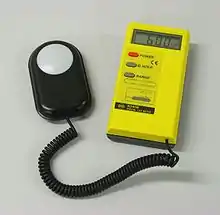 A lux meter for measuring illuminance | |
| General information | |
| Unit system | SI derived unit |
| Unit of | illuminance |
| Symbol | lx |
| Conversions | |
| 1 lx in ... | ... is equal to ... |
| American Customary units | 0.0929 fc |
| CGS units | 10−4 phots |
Explanation
Illuminance
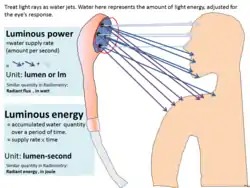
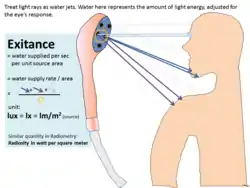
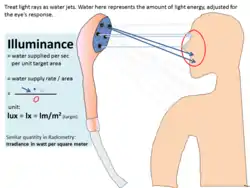
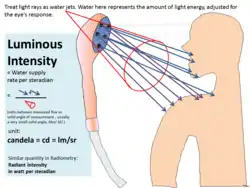
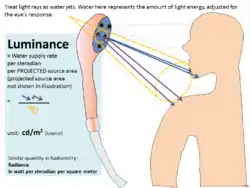
Illuminance is a measure of how much luminous flux is spread over a given area. One can think of luminous flux (measured in lumens) as a measure of the total "amount" of visible light present, and the illuminance as a measure of the intensity of illumination on a surface. A given amount of light will illuminate a surface more dimly if it is spread over a larger area, so illuminance is inversely proportional to area when the luminous flux is held constant.
One lux is equal to one lumen per square metre:
A flux of 1000 lumens, spread uniformly over an area of 1 square metre, lights up that square metre with an illuminance of 1000 lux. However, the same 1000 lumens spread out over 10 square metres produces a dimmer illuminance of only 100 lux.
Achieving an illuminance of 500 lux might be possible in a home kitchen with a single fluorescent light fixture with an output of 12000 lumens. To light a factory floor with dozens of times the area of the kitchen would require dozens of such fixtures. Thus, lighting a larger area to the same level of lux requires a greater number of lumens.
As with other SI units, SI prefixes can be used, for example a kilolux (klx) is 1000 lux.
Here are some examples of the illuminance provided under various conditions:
| Illuminance (lux) | Surfaces illuminated by |
|---|---|
| 0.0001 | Moonless, overcast night sky (starlight)[4] |
| 0.002 | Moonless clear night sky with airglow[4] |
| 0.05–0.3 | Full moon on a clear night[5] |
| 3.4 | Dark limit of civil twilight under a clear sky[6] |
| 20–50 | Public areas with dark surroundings[7] |
| 50 | Family living room lights (Australia, 1998)[8] |
| 80 | Office building hallway/toilet lighting[9][10] |
| 100 | Very dark overcast day[4] |
| 150 | Train station platforms[11] |
| 320–500 | Office lighting[8][12][13][14] |
| 400 | Sunrise or sunset on a clear day. |
| 1000 | Overcast day;[4] typical TV studio lighting |
| 10,000–25,000 | Full daylight (not direct sun)[4] |
| 32,000–100,000 | Direct sunlight |
The illuminance provided by a light source on a surface perpendicular to the direction to the source is a measure of the strength of that source as perceived from that location. For instance, a star of apparent magnitude 0 provides 2.08 microlux (μlx) at the Earth's surface.[15] A barely perceptible magnitude 6 star provides 8 nanolux (nlx).[16] The unobscured Sun provides an illumination of up to 100 kilolux (klx) on the Earth's surface, the exact value depending on time of year and atmospheric conditions. This direct normal illuminance is related to the solar illuminance constant Esc, equal to 128000 lux (see Sunlight and Solar constant).
The illuminance on a surface depends on how the surface is tilted with respect to the source. For example, a pocket flashlight aimed at a wall will produce a given level of illumination if aimed perpendicular to the wall, but if the flashlight is aimed at increasing angles to the perpendicular (maintaining the same distance), the illuminated spot becomes larger and so is less highly illuminated. When a surface is tilted at an angle to a source, the illumination provided on the surface is reduced because the tilted surface subtends a smaller solid angle from the source, and therefore it receives less light. For a point source, the illumination on the tilted surface is reduced by a factor equal to the cosine of the angle between a ray coming from the source and the normal to the surface.[17] In practical lighting problems, given information on the way light is emitted from each source and the distance and geometry of the lighted area, a numerical calculation can be made of the illumination on a surface by adding the contributions of every point on every light source.
Relationship between illuminance and irradiance
Like all photometric units, the lux has a corresponding "radiometric" unit. The difference between any photometric unit and its corresponding radiometric unit is that radiometric units are based on physical power, with all wavelengths being weighted equally, while photometric units take into account the fact that the human eye's image-forming visual system is more sensitive to some wavelengths than others, and accordingly every wavelength is given a different weight. The weighting factor is known as the luminosity function.
The lux is one lumen per square metre (lm/m2), and the corresponding radiometric unit, which measures irradiance, is the watt per square metre (W/m2). There is no single conversion factor between lux and W/m2; there is a different conversion factor for every wavelength, and it is not possible to make a conversion unless one knows the spectral composition of the light.
The peak of the luminosity function is at 555 nm (green); the eye's image-forming visual system is more sensitive to light of this wavelength than any other. For monochromatic light of this wavelength, the amount of illuminance for a given amount of irradiance is maximum: 683.002 lux per 1 W/m2; the irradiance needed to make 1 lux at this wavelength is about 1.464 mW/m2. Other wavelengths of visible light produce fewer lux per watt-per-meter-squared. The luminosity function falls to zero for wavelengths outside the visible spectrum.
For a light source with mixed wavelengths, the number of lumens per watt can be calculated by means of the luminosity function. In order to appear reasonably "white", a light source cannot consist solely of the green light to which the eye's image-forming visual photoreceptors are most sensitive, but must include a generous mixture of red and blue wavelengths, to which they are much less sensitive.
This means that white (or whitish) light sources produce far fewer lumens per watt than the theoretical maximum of 683.002 lm/W. The ratio between the actual number of lumens per watt and the theoretical maximum is expressed as a percentage known as the luminous efficiency. For example, a typical incandescent light bulb has a luminous efficiency of only about 2%.
In reality, individual eyes vary slightly in their luminosity functions. However, photometric units are precisely defined and precisely measurable. They are based on an agreed-upon standard luminosity function based on measurements of the spectral characteristics of image-forming visual photoreception in many individual human eyes.
Use in video-camera specifications
Specifications for video cameras such as camcorders and surveillance cameras often include a minimal illuminance level in lux at which the camera will record a satisfactory image. A camera with good low-light capability will have a lower lux rating. Still cameras do not use such a specification, since longer exposure times can generally be used to make pictures at very low illuminance levels, as opposed to the case in video cameras, where a maximal exposure time is generally set by the frame rate.
Non-SI units of illuminance
The corresponding unit in English and American traditional units is the foot-candle. One foot candle is about 10.764 lux. Since one foot-candle is the illuminance cast on a surface by a one-candela source one foot away, a lux could be thought of as a "metre-candle", although this term is discouraged because it does not conform to SI standards for unit names.
One phot (ph) equals 10 kilolux (10 klx).
One nox (nx) equals 1 millilux (1 mlx).
In astronomy, apparent magnitude is a measure of the illuminance of a star on the Earth's atmosphere. A star with apparent magnitude 0 is 2.54 microlux outside the earth's atmosphere, and 82% of that (2.08 microlux) under clear skies.[15] A magnitude 6 star (just barely visible under good conditions) would be 8.3 nanolux. A standard candle (one candela) a kilometre away would provide an illuminance of 1 microlux—about the same as a magnitude 1 star.
Legacy Unicode symbol
Unicode has a symbol for "lx": (㏓). It is a legacy code to accommodate old code pages in some Asian languages. Use of this code is not recommended.
SI photometry units
| Quantity | Unit | Dimension | Notes | |||||
|---|---|---|---|---|---|---|---|---|
| Name | Symbol[nb 1] | Name | Symbol | Symbol[nb 2] | ||||
| Luminous energy | Qv[nb 3] | lumen second | lm⋅s | T J | The lumen second is sometimes called the talbot. | |||
| Luminous flux, luminous power | Φv[nb 3] | lumen (= candela steradians) | lm (= cd⋅sr) | J | Luminous energy per unit time | |||
| Luminous intensity | Iv | candela (= lumen per steradian) | cd (= lm/sr) | J | Luminous flux per unit solid angle | |||
| Luminance | Lv | candela per square metre | cd/m2 (= lm/(sr⋅m2)) | L−2J | Luminous flux per unit solid angle per unit projected source area. The candela per square metre is sometimes called the nit. | |||
| Illuminance | Ev | lux (= lumen per square metre) | lx (= lm/m2) | L−2J | Luminous flux incident on a surface | |||
| Luminous exitance, luminous emittance | Mv | lumen per square metre | lm/m2 | L−2J | Luminous flux emitted from a surface | |||
| Luminous exposure | Hv | lux second | lx⋅s | L−2T J | Time-integrated illuminance | |||
| Luminous energy density | ωv | lumen second per cubic metre | lm⋅s/m3 | L−3T J | ||||
| Luminous efficacy (of radiation) | K | lumen per watt | lm/W | M−1L−2T3J | Ratio of luminous flux to radiant flux | |||
| Luminous efficacy (of a source) | η[nb 3] | lumen per watt | lm/W | M−1L−2T3J | Ratio of luminous flux to power consumption | |||
| Luminous efficiency, luminous coefficient | V | 1 | Luminous efficacy normalized by the maximum possible efficacy | |||||
| See also: SI · Photometry · Radiometry | ||||||||
- Standards organizations recommend that photometric quantities be denoted with a subscript "v" (for "visual") to avoid confusion with radiometric or photon quantities. For example: USA Standard Letter Symbols for Illuminating Engineering USAS Z7.1-1967, Y10.18-1967
- The symbols in this column denote dimensions; "L", "T" and "J" are for length, time and luminous intensity respectively, not the symbols for the units litre, tesla and joule.
- Alternative symbols sometimes seen: W for luminous energy, P or F for luminous flux, and ρ for luminous efficacy of a source.
See also
Notes and references
- SI Derived Units, National Institute of Standards and Technology.
- "Lux". Lighting / Radiation, quantities and units. International Electrotechnical Commission. 1987. Retrieved 30 November 2019.
- NIST Guide to SI Units. Chapter 9 – Rules and Style Conventions for Spelling Unit Names, National Institute of Standards and Technology.
- Schlyter, Paul (1997–2009). "Radiometry and photometry in astronomy".
Starlight illuminance coincides with the human eye's minimum illuminance while moonlight coincides with the human eye's minimum colour vision illuminance (IEE Reviews, 1972, page 1183). - Kyba, Christopher C. M.; Mohar, Andrej; Posch, Thomas (1 February 2017). "How bright is moonlight?". Astronomy & Geophysics. 58 (1): 1.31–1.32. doi:10.1093/astrogeo/atx025.
- "Electro-Optics Handbook" (pdf). photonis.com. p. 63. Retrieved 2 April 2012.
- "NOAO Commen and Recommended Light Levels Indoor" (PDF).
- Pears, Alan (June 1998). "Chapter 7: Appliance technologies and scope for emission reduction". Strategic Study of Household Energy and Greenhouse Issues (PDF). Sustainable Solutions Pty Ltd. Department of Industry and Science, Commonwealth of Australia. p. 61. Archived from the original (PDF) on 2 March 2011. Retrieved 26 June 2008.
- Australian Greenhouse Office (May 2005). "Chapter 5: Assessing lighting savings". Working Energy Resource and Training Kit: Lighting. Archived from the original on 15 April 2007. Retrieved 17 March 2007.
- "Low-Light Performance Calculator". Archived from the original on 15 June 2013. Retrieved 27 September 2010.
- Darlington, Paul (5 December 2017). "London Underground: Keeping the lights on". Rail Engineer. Retrieved 20 December 2017.
- "How to use a lux meter (Australian recommendation)" (PDF). Sustainability Victoria. April 2010. Archived from the original (PDF) on 7 July 2011.
- "Illumination. - 1926.56". Regulations (Standards - 29 CFR). Occupational Safety and Health Administration, US Dept. of Labor. Archived from the original on 8 May 2009.
- European law UNI EN 12464
- Schlyter, Section 7.
- Schlyter, Section 14.
- Jack L. Lindsey, Applied Illumination Engineering, The Fairmont Press, Inc., 1997 ISBN 0881732125 page 218
External links
- Radiometry and photometry FAQ Professor Jim Palmer's Radiometry FAQ page (University of Arizona).
